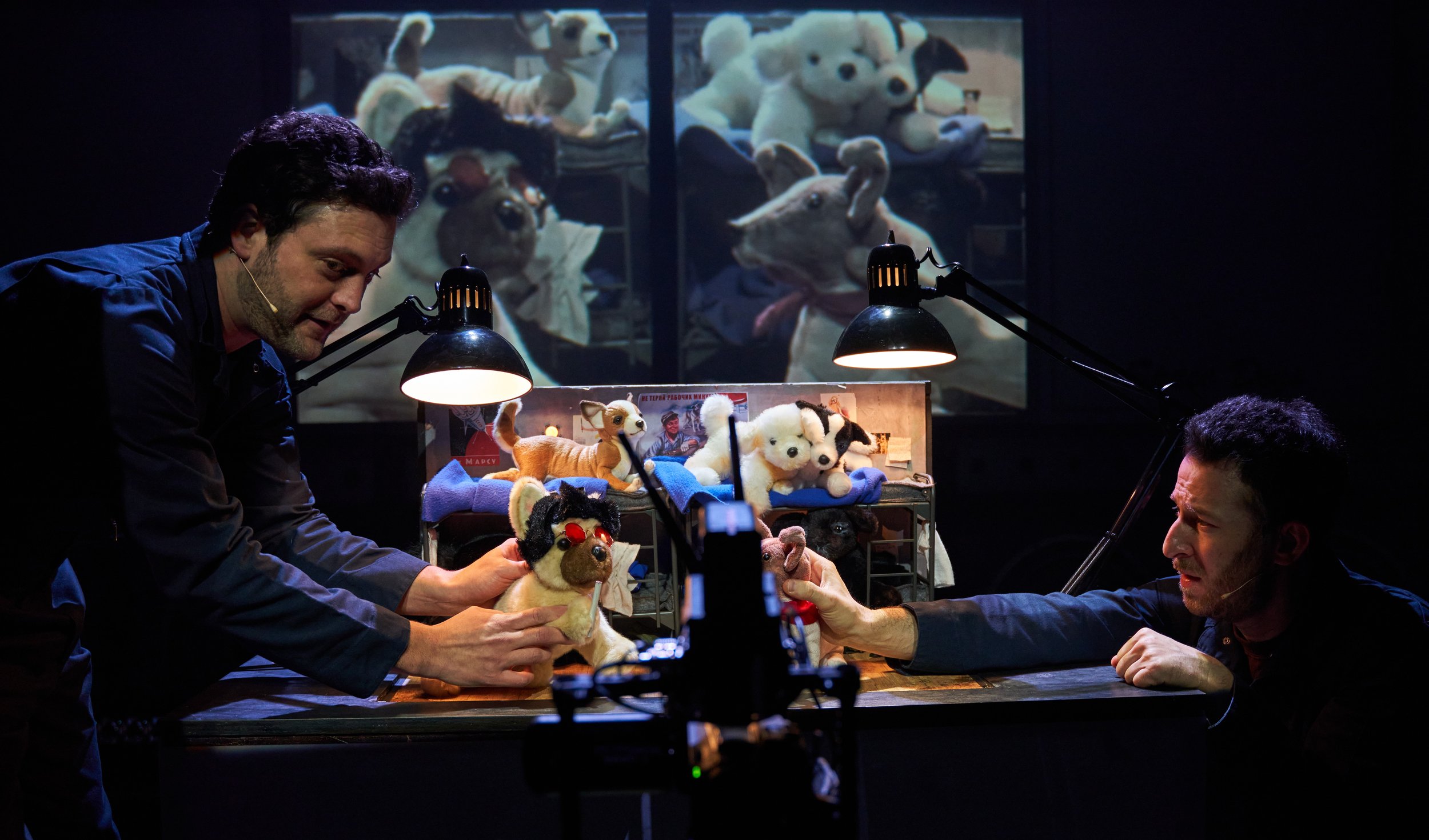Nick Blaemire (left) and Van Hughes, on electric guitars, belt out a duet in Space Dogs.
It seems a near-impossible task to take on an historical, highly politicized, and contentious international topic, and successfully morph it into a high-tech, semi-satirical pop-rock musical. Nevertheless, with Space Dogs, playwrights-composers-lyricists Van Hughes and Nick Blaemire have done exactly that. They have etched out the broader landscape of what was perhaps the most frightening, longest-running, and potentially deadliest conflict of the late 20th century—the Cold War.
Hughes’ and Blaemire’s satire and music could well have revolved around mutually assured destruction (MAD), à la Dr. Strangelove. Instead, they have deflected the threat of nuclear annihilation and zeroed in on the Soviet—U.S. competition for dominance in the race for space. Their focus is the “space dogs” of the title—forerunners of and catalysts for the U.S.S.R. cosmonauts’ achievements. The show, based on a true story, reflects the perspective of Laika, the favored Soviet space dog, as much as it does that of the Chief Designer, a sequestered Soviet scientist and former gulag internee. Hidden in a top-secret facility, he manipulates Laika and other dogs and routinely performs bizarre experiments on them to advance Soviet space capabilities. Given that Laika, the captured street mongrel, is so lovable, charming, and loquacious, the result is anthropomorphism at its best. Director Ellie Heyman has taken Hughes’ and Blaemire’s script, with its disparate technical, musical, and historical-narrative threads, and woven a dazzling, relevant production.
Blaemire (left), as Oleg of the Cosmodrome, holds and sings to Laika, the space dog. Hughes, as Chief Designer, accompanies him.
Hughes and Blaemire have incorporated stuffed animals, which are ordinarily juvenile playthings, given them human attributes and emotions, and assigned them starring roles. Although doggie sagas don’t ordinarily cut it as adult fare, somehow Space Dogs works.
On one level, the musical depicts the ruthlessness of a Soviet machine that uses, abuses, and then discards its loyal subjects. On the other hand, Hughes’ portrayal of the Chief Designer (whose real identity is only revealed long after his death), exudes a genuine warmth and affection for Laika, and despite his multiple experiments on her, he mourns her death, and she haunts him. His relationship with Laika has far more humanity and positive interaction than what he has with Soviet Premier Nikita Khrushchev, or any other colleagues. He genuinely cares for Laika, yet he betrays her and sends her, unknowing, to her death. Ultimately, the Chief Designer is as morally ambiguous as any of the party leaders he serves. He is driven by the terror of what might befall him if he fails in his mission. He can always be sent back to the gulag.
Hughes’ and Blaemire’s electric guitar and keyboard duets, combined with their choreographed moves, are riveting and ironic, especially when offset by militaristic and nationalist projections. They include an alternately smiling and aggressive Khrushchev, but it’s not just the Soviets who are the targets of ironic, sometimes cruel jibes. When the U.S. lags in the space race, Lyndon Baines Johnson calls for new scientists. “How bout them Germans, they’re unemployed, ain’t they?” he asks David Bianculli, who answers, “Well sure, but---but they’re also war criminals.” Segue to “Werner Von Braun,” where Hughes and Blaemire sing about Operation Paperclip, the U.S.’s postwar top-secret recruitment of about 1,600 German scientists: “After World War II, we hired a Nazi, we hired a Nazi,” they chant. This attempt to give the U.S. the scientific upper hand, which the Soviets’ matched by hiring more than 2,000 Nazis, are equally morally ambiguous. Blaemire chimes in: “After World War II, President Truman made it illegal to hire Nazis—but once we found we were losing the space race, well. Surprise, we did it anyway.” Hughes, as Werner von Braun, appearing in a long, leather-like Gestapo coat, is a shout-out to Nazi expatriates under contract to the U.S. government.
Hughes (left) and Blaemire voice the conversation between dogs Little Gnat (left) and Laika, respectively.
The show glitters and glows—literally and figuratively. The set (Wilson Chin), lighting (Mary Ellen Stebbins), projection design (Stefania Bulbarella and Alex Basco Koch), costume design (Haydee Zelideth Atuñano), and sound design (Nathan Leigh) create a formidable cacophony of sounds and images. The backdrop pulsates with historic footage of Khrushchev, von Braun, Soviet space launches, a sinister mushroom cloud, LBJ, and other American space-race proponents. As actors, Blaemire and Hughes navigate through a multitude of world leaders down to security guards, and provide the vocals for Laika and her canine buddies.
The consummate merger of superb technical effects, brilliant musicianship, and a poignant story contextualized in an era of tension and international intrigue create a unique, holistic theatrical experience, one with great relevance to our times.
The MCC Theater production of Space Dogs plays at the Robert W. Wilson MCC Theater (511 W. 52nd St.) through March 20. Evening performances are at 7:30 p.m. Mondays, Tuesdays, Thursdays, Fridays and Saturdays; matinees are at 2:30 p.m. on Saturdays and Sundays. For more information, contact the box office at (646) 506-9393 or visit mcctheater.org.





